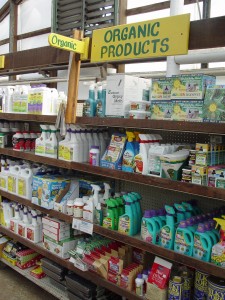Ditching the chemicals?
September 15th, 2010
I’ve always thought the biggest strike against so-called organic products is cost.
People might be willing to pay a little more for something they believe is “safer” or less polluting, but few will pay a lot more.
When a bottle of oil-based Veggie-Pharm costs $12.99 and a bottle of Ortho is going for $6.99, it’s easy to understand what wins out.
That price disparity is finally shrinking — at least at the big-box level.
I had an interesting talk about this at last week’s Garden Writers Association conference with a vendor from Eco-Smart.
This is the Georgia-based company that makes a whole line of home and garden organic products that sell at Wal-Mart, Home Depot and Lowe’s.
The vendor told me that organics actually have had three main hurdles.
Lack of availability was a big one that’s now no issue since consumer demand drove big chemical players such as Scott’s and Bayer into the organic arena (not to mention a boatload of small-company offerings).
The second hurdle was convincing consumers that organics actually work.
The jury’s still out on that. People are used to seeing dead bugs drop, and most organic or “natural” products don’t work that way.
For the most part, organics work more slowly and need to be applied more often and in more targeted ways. It takes some readjusting your expectations and game plan. But by and large, most organics are effective in ways that are helpful to non-target life and the environment.
That leaves cost. Eco-Smart has managed to bring down its organic prices to levels that match their chemical counterparts.
How? Economy of scale.
Up until recently, almost all organics have been a niche market filled by single-line products made by very small companies.
“We can get rosemary oil a lot cheaper when we buy hundreds of barrels instead of one or two at a time like a small company,” the Eco-Smart source told me.
Another help when you’re big and more diverse — it breeds consumer confidence.
“When someone tries one of our products and it works, they’re much more willing to use something else,” my source said.
There’s none of that broader loyalty when you encounter the old “organic section” that has a mish-mash of labels, brands and product names. When you see one consistent line of products, people tend to give it more credibility.
I’m not sure everyone in the organic field agrees with the importance or impact of higher price. Eco-Smart gets it because their people go into stores and watch what shoppers do when they approach the pesticide section.
I’m convinced that given equal or even close prices, a majority of mainstream consumers will opt for the organic choice. So long as organics are priced significantly higher, it’ll stay a niche market.
I’ve always preferred small independent stores to big-box chains, but if that’s what finally breaks our reliance on unnecessarily toxic chemicals, it’s a good thing.
Fixing the lawn — again
Lots of gardeners are patching their dead lawns once again. It’s getting to be an annual ritual, what with heat, drought, grubs, chinch bugs, disease, etc. etc.
Mid-September through the end of October is prime time to repair the dead spots. If you missed the Patriot-News piece I did a few weeks ago on how to patch your lawn, here’s a link to it along with additional info that didn’t appear in print: https://georgeweigel.net/favorite-past-garden-columns/lawns/fixing-a-dead-lawn.








